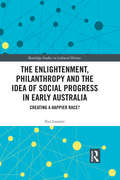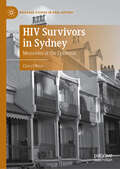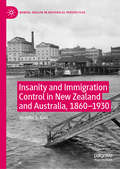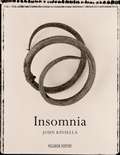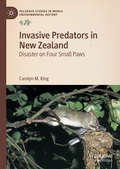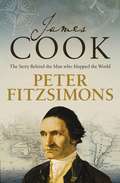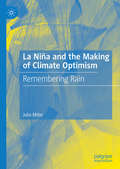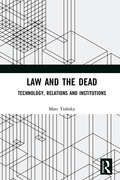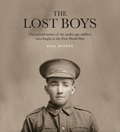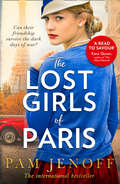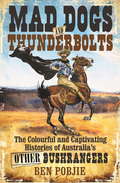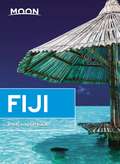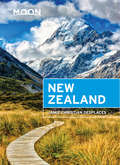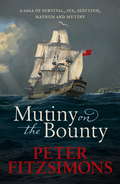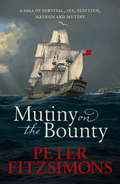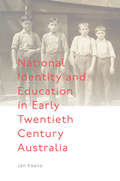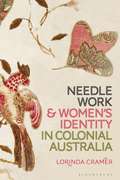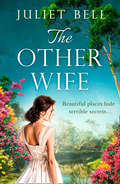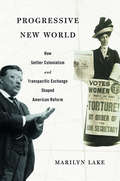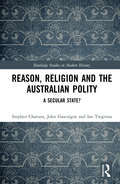- Table View
- List View
The Enlightenment, Philanthropy and the Idea of Social Progress in Early Australia: Creating a Happier Race? (Routledge Studies in Cultural History #63)
by Ilya LazarevThis book seeks to highlight the influence of the Enlightenment idea of social progress on the character of the "civilising mission" in early Australia by tracing its presence in the various "civilising" attempts undertaken between 1788 and 1850. It also represents an attempt to marry the history of the British Enlightenment and the history of settler-Aboriginal interactions. The chronological structure of the book, as well as the breadth of its content, will facilitate the readers’ understanding of the evolution of "civilising attempts" and their epistemological underpinnings, while throwing additional light on the influence of the Enlightenment on Australian history as a whole.
The Enlightenment, Philanthropy and the Idea of Social Progress in Early Australia: Creating a Happier Race? (Routledge Studies in Cultural History #63)
by Ilya LazarevThis book seeks to highlight the influence of the Enlightenment idea of social progress on the character of the "civilising mission" in early Australia by tracing its presence in the various "civilising" attempts undertaken between 1788 and 1850. It also represents an attempt to marry the history of the British Enlightenment and the history of settler-Aboriginal interactions. The chronological structure of the book, as well as the breadth of its content, will facilitate the readers’ understanding of the evolution of "civilising attempts" and their epistemological underpinnings, while throwing additional light on the influence of the Enlightenment on Australian history as a whole.
HIV Survivors in Sydney: Memories of the Epidemic (Palgrave Studies in Oral History)
by Cheryl WareInner-city Sydney was the epicenter of gay life in the Southern hemisphere in the 1970s and early 1980s. Gay men moved from across Australasia to find liberation in the city’s vibrant community networks; and when HIV and AIDS devastated those networks, they grieved, suffered, and survived in ways that have often been left out of the historical record. This book excavates the intimate lives and memories of HIV-positive gay men in Sydney, focusing on the critical years between 1982 and 1996, when HIV went from being a terrifying unidentified disease to a chronic condition that could be managed with antiretroviral medication. Using oral histories and archival research, Cheryl Ware offers a sensitive, moving exploration of how HIV-positive gay men navigated issues around disclosure, health, sex, grief, death, and survival. HIV Survivors in Sydney reveals how gay men dealt with the virus both within and outside of support networks, and how they remember these experiences nearly three decades later.
Insanity and Immigration Control in New Zealand and Australia, 1860–1930 (Mental Health in Historical Perspective)
by Jennifer S. KainThis book examines the policy and practice of the insanity clauses within the immigration controls of New Zealand and the Commonwealth of Australia. It reveals those charged with operating the legislation to be non-psychiatric gatekeepers who struggled to match its intent. Regardless of the evolution in language and the location at which a migrant’s mental suitability was assessed, those with ‘inherent mental defects’ and ‘transient insanity’ gained access to these regions. This book accounts for the increased attempts to medicalise border control in response to the widening scope of terminology used for mental illnesses, disabilities and dysfunctions. Such attempts co-existed with the promotion of these regions as ‘invalids’ paradises’ by governments, shipping companies, and non-asylum doctors. Using a bureaucratic lens, this book exposes these paradoxes, and the failings within these nineteenth- and early twentieth-century Australasian nation-state building exercises.
Insomnia
by John KinsellaThe Australian poet John Kinsella’s vivid and urgent new collection addresses the crisis of being that currently afflicts us: Kinsella addresses a situation where the creations of the human imagination, the very means by which we extend our empathies into the world – art, music and philosophy – suddenly find themselves in a world that not only denies their importance, but can sometimes seem to have no use for them at all. In an attempt to find a still point from which we might reconfigure our perspective and address the paradoxes of our contemporary experience, Kinsella has written poems of self-accusation and angry protest, meditations on the nature of loss and trauma, and full-throated celebrations of the natural world. Ranging from Jam Tree Gully, Western Australia to the coast of West Cork, Ireland, haunted by historical and literary figures from Dante to Emily Brontë (whom Kinsella has obsessed over since he was a child, and who intervenes in the poet’s attempts to come to grips with ideas of colonization and identity), Insomnia may be Kinsella’s most various and powerful collection to date.
Invasive Predators in New Zealand: Disaster on Four Small Paws (Palgrave Studies in World Environmental History)
by Carolyn M. KingThe story of invasive species in New Zealand is unlike any other in the world. By the mid-thirteenth century, the main islands of the country were the last large landmasses on Earth to remain uninhabited by humans, or any other land mammals. New Zealand’s endemic fauna evolved in isolation until first Polynesians, and then Europeans, arrived with a host of companion animals such as rats and cats in tow. Well-equipped with teeth and claws, these small furry mammals, along with the later arrival of stoats and ferrets, have devastated the fragile populations of unique birds, lizards and insects. Carolyn M. King brings together the necessary historical analysis and recent ecological research to understand this long, slow tragedy. As a comprehensive historical perspective on the fate of an iconic endemic fauna, this book offers much-needed insight into one of New Zealand’s longest-running national crises.
James Cook: The story of the man who mapped the world
by Peter FitzSimonsCaptain James Cook is one of the most recognisable in Australian history - an almost mythic figure who is often discussed, celebrated, reviled and debated. But who was the real James Cook?The name Captain James Cook is one of the most recognisable in Australian history - an almost mythic figure who is often discussed, celebrated, reviled and debated.But who was the real James Cook?This Yorkshire farm boy would go on to become the foremost mariner, navigator and cartographer of his era, and to personally map a third of the globe. His great voyages of discovery were incredible feats of seamanship and navigation. Leading a crew of men into uncharted territories, Cook would face the best and worst of humanity as he took himself and his crew to the edge of the known world - and beyond.With his masterful storytelling talent, Peter FitzSimons brings James Cook to life. Focusing on his most iconic expedition, the voyage of the Endeavour, where Cook first set foot on Australian and New Zealand soil, FitzSimons contrasts Cook against another figure who looms large in Australasian history: Joseph Banks, the aristocratic botanist. As they left England, Banks, a rich, famous playboy, was everything that Cook was not. The voyage tested Cook's character and would help define his legacy.Now, 240 years after James Cook's death, FitzSimons reveals what kind of man James was at heart. His strengths, his weaknesses, his passions and pursuits, failures and successes.JAMES COOK reveals the man behind the myth.
La Niña and the Making of Climate Optimism: Remembering Rain
by Julia MillerThis book examines the deep connection Australians have with their climate to understand contemporary views on human-induced climate change. It is the first study of the Australian relationship with La Niña and it explains how fundamental this relationship is to the climate change debate both locally and globally. While unease with the Australian environment was a hallmark of early settler relations with a new continent, this book argues that the climate itself quickly became a source of hope and linked to progress. Once observed, weather patterns coalesced into recognizable cycles of wet and dry years and Australians adopted a belief in the certainty of good seasons. It was this optimistic response to climate linked to La Niña that laid the groundwork for this relationship with the Australian environment. This book will appeal to scholars and students of the environmental humanities, history and science as well as anyone concerned about climate change.
Law and the Dead: Technology, Relations and Institutions
by Marc TrabskyThe governance of the dead in the eighteenth and nineteenth centuries gave rise to a new arrangement of thanato-politics in the West. Legal, medical and bureaucratic institutions developed innovative technologies for managing the dead, maximising their efficacy and exploiting their vitality. Law and the Dead writes a history of their institutional life in the nineteenth and twentieth centuries. With a particular focus on the technologies of the death investigation process, including place-making, the forensic gaze, bureaucratic manuals, record-keeping and radiography, this book examines how the dead came to be incorporated into legal institutions in the modern era. Drawing on the writings of philosophers, historians and legal theorists, it offers tools for thinking through how the dead dwell in law, how their lives persist through the conduct of office, and how coroners assume responsibility for taking care of the dead. This historical and interdisciplinary book offers a provocative challenge to conventional thinking about the sequestration of the dead in the nineteenth and twentieth centuries. It asks the reader to think through and with legal institutions when writing a history of the dead, and to trace the important role assumed by coroners in the governance of the dead. This book will be of interest to scholars working in law, history, sociology and criminology.
Law and the Dead: Technology, Relations and Institutions
by Marc TrabskyThe governance of the dead in the eighteenth and nineteenth centuries gave rise to a new arrangement of thanato-politics in the West. Legal, medical and bureaucratic institutions developed innovative technologies for managing the dead, maximising their efficacy and exploiting their vitality. Law and the Dead writes a history of their institutional life in the nineteenth and twentieth centuries. With a particular focus on the technologies of the death investigation process, including place-making, the forensic gaze, bureaucratic manuals, record-keeping and radiography, this book examines how the dead came to be incorporated into legal institutions in the modern era. Drawing on the writings of philosophers, historians and legal theorists, it offers tools for thinking through how the dead dwell in law, how their lives persist through the conduct of office, and how coroners assume responsibility for taking care of the dead. This historical and interdisciplinary book offers a provocative challenge to conventional thinking about the sequestration of the dead in the nineteenth and twentieth centuries. It asks the reader to think through and with legal institutions when writing a history of the dead, and to trace the important role assumed by coroners in the governance of the dead. This book will be of interest to scholars working in law, history, sociology and criminology.
The Lost Boys
by Paul ByrnesIn the First World War of 1914–1918, thousands of boys across Australia and New Zealand lied about their age, forged a parent’s signature and left to fight on the other side of the world. Though some were as young as thirteen, they soon found they could die as well as any man. Like Peter Pan’s lost boys, they have remained forever young. These are their stories. This extraordinary book captures the incredible and previously untold stories of forty Anzac boys who fought in the First World War, from Gallipoli to the Armistice. Featuring haunting images of the boys taken at training camps and behind the lines, these tales are both heartbreaking and rousing, full of daring, ingenuity, recklessness, random horror and capricious luck. A unique perspective on the First World War, The Lost Boys is military history made deeply personal, a powerful homage to youthful bravery and a poignant reminder of the sacrifice of war.
The Lost Girls Of Paris: The Bon Bon Girl / The Flower Seller / The Very White Of Love / Paris By The Book / The Lost Girls Of Paris (Hq Fiction Ebook Ser.)
by Pam Jenoff‘A gripping tale’ MY WEEKLY‘Thrilling’ WOMAN‘A truly gripping read of mystery, love and heroism’ FROST MAGAZINE The Lost Girls of Paris is an emotional story of friendship and betrayal during the second world war, inspired by true events – from the international bestseller Pam Jenoff.
Mad Dogs and Thunderbolts
by Ben PobjieNed Kelly’s tin helmet looms large over Australia’s bushranging past, but what about all the unsung outlaws of the Australian bush? What about Black Caesar, who escaped his tyrannous British overlords four times and indeed invented the great Australian tradition of bushranging? Or Mad Dog Morgan who set out to write his name in blood on history’s ledger, the dynamic Captain Thunderbolt and his loyal wife Mary Ann Bugg, bushranging’s greatest queen, and Matthew Brady, the gentleman bushranger, who showed us all the cilivised side of armed robbery? In Mad Dogs and Thunderbolts Ben Pobjie celebrates the derring-do and revolutionary passion of all the wild colonial boys and girls who raided our towns and stole our hearts, all while wearing sensible headgear.
Moon Fiji (Travel Guide)
by Minal HajratwalaExplore the colorful reefs, volcanic canyons, emerald rainforests, and unspoiled beaches of this sparkling archipelago with Moon Fiji. Inside you'll find:Flexible itineraries including four days on Taveuni Island, five days of island-hopping in the Yasawas, and the ten-day best of FijiStrategic advice for outdoor adventurers, diving enthusiasts, honeymooners, foodies, and more, with guidance on which island is right for youMust-see highlights and unique experiences: Go scuba-diving and spot barracuda, manta rays, and dolphins. Hike the rain-filled crater of a dormant volcano, raft down the thrilling Navua River, or zip-line through old-growth yesi forests. Share an intoxicating bowl of kava with new friends, tour an inland sugar plantation, or immerse yourself in the vibrant culture of indigenous peoples at a VOU dance performance. Sample fresh papaya, passionfruit, and mangoes from local growers or go off the grid in a traditional Fijian village, where you can practice mountainside yoga and learn to river fish with localsExpert insight: Minal Hajratwala, a writer with lifelong family ties to Fiji, recommends where to eat, how to get around, and where to stay, from guest cottages and beach bungalows to luxurious resortsFull-color photos and detailed maps throughoutReliable background information on the landscape, climate, wildlife, and history, as well as common customs, etiquette, and basic Fijian and Hindi phrasebooksHandy tips for families, seniors, students, and travelers with disabilities, plus ideas for traveling sustainably and engaging with the cultureWith Moon Fiji's practical tips and local know-how, you can experience the best of Fiji.Exploring the South Pacific? Check out Moon New Zealand.
Moon Fiji (Travel Guide)
by Minal HajratwalaExplore the colorful reefs, volcanic canyons, emerald rainforests, and unspoiled beaches of this sparkling archipelago with Moon Fiji. Inside you'll find:Flexible itineraries including four days on Taveuni Island, five days of island-hopping in the Yasawas, and the ten-day best of FijiStrategic advice for outdoor adventurers, diving enthusiasts, honeymooners, foodies, and more, with guidance on which island is right for youMust-see highlights and unique experiences: Go scuba-diving and spot barracuda, manta rays, and dolphins. Hike the rain-filled crater of a dormant volcano, raft down the thrilling Navua River, or zip-line through old-growth yesi forests. Share an intoxicating bowl of kava with new friends, tour an inland sugar plantation, or immerse yourself in the vibrant culture of indigenous peoples at a VOU dance performance. Sample fresh papaya, passionfruit, and mangoes from local growers or go off the grid in a traditional Fijian village, where you can practice mountainside yoga and learn to river fish with localsExpert insight: Minal Hajratwala, a writer with lifelong family ties to Fiji, recommends where to eat, how to get around, and where to stay, from guest cottages and beach bungalows to luxurious resortsFull-color photos and detailed maps throughoutReliable background information on the landscape, climate, wildlife, and history, as well as common customs, etiquette, and basic Fijian and Hindi phrasebooksHandy tips for families, seniors, students, and travelers with disabilities, plus ideas for traveling sustainably and engaging with the cultureWith Moon Fiji's practical tips and local know-how, you can experience the best of Fiji.Exploring the South Pacific? Check out Moon New Zealand.
Moon New Zealand (Travel Guide)
by Jamie Christian DesplacesFrom green forests to blackened basalt, from snowy mountains to golden beaches, adventure awaits around every bend on these dramatic islands. Dive into Middle Earth with Moon New Zealand. Inside you'll find:Strategic itineraries including a week on both the North and South Islands, designed for hikers, cyclers, adrenaline junkies, history and culture buffs, and Lord of the Rings fansThe top spots for outdoor adventures, including surfing, bungy jumping, mountain biking, and trekking the Great Walks, as well as tips on how to do a New Zealand road tripThe top sights and unique experiences: Cruise the hypnotic black waters of the Milford Sound, spot wild dolphins, kiwis, and blue penguins, and explore the sprawling Waitomo Caves lit by twinkling glowworms. Go bungy jumping, paragliding, or jet skiing in Queensland, or soak in refreshing thermal pools. Embark on a multi-day trek to rugged coasts, glacial valleys, volcanoes, and fjords. Sample local sauvignon blancs in Marlborough and craft beers in Wellington, or sip cider in the Shire. Learn about Polynesian culture and history, marvel at Maori carvings, and savor a traditional hangiHow to experience New Zealand like an insider, support local and sustainable businesses, avoid crowds, and respectfully engage with the indigenous cultureExpert insight from Auckland local Jamie Christian Desplaces on when to go, how to get around, and where to stay Full-color photos and detailed maps throughout, plus a full-color detachable mapReliable background information on the landscape, climate, wildlife, and history, as well as common customs and etiquette Travel tips for seniors, families with children, visitors with disabilities, and LGBTQ travelersWith Moon New Zealand's expert advice and local insight, you can plan your trip your way.
Mutiny on the Bounty: A saga of sex, sedition, mayhem and mutiny, and survival against extraordinary odds
by Peter FitzSimonsThe mutiny on HMS Bounty, in the South Pacific on 28 April 1789, is one of history's truly great stories - a tale of human drama, intrigue and adventure of the highest order - and in the hands of Peter FitzSimons it comes to life as never before.Commissioned by the Royal Navy to collect breadfruit plants from Tahiti and take them to the West Indies, the Bounty's crew found themselves in a tropical paradise. Five months later, they did not want to leave. Under the leadership of Fletcher Christian most of the crew mutinied soon after sailing from Tahiti, setting Captain William Bligh and 18 loyal crewmen adrift in a small open boat. In one of history's great feats of seamanship, Bligh navigated this tiny vessel for 3618 nautical miles to Timor.Fletcher Christian and the mutineers sailed back to Tahiti, where most remained and were later tried for mutiny. But Christian, along with eight fellow mutineers and some Tahitian men and women, sailed off into the unknown, eventually discovering the isolated Pitcairn Island - at the time not even marked on British maps - and settling there.This astonishing story is historical adventure at its very best, encompassing the mutiny, Bligh's monumental achievement in navigating to safety, and Fletcher Christian and the mutineers' own epic journey from the sensual paradise of Tahiti to the outpost of Pitcairn Island. The mutineers' descendants live on Pitcairn to this day, amid swirling stories and rumours of past sexual transgressions and present-day repercussions. Mutiny on the Bounty is a sprawling, dramatic tale of intrigue, bravery and sheer boldness, told with the accuracy of historical detail and total command of story that are Peter FitzSimons' trademarks.
Mutiny on the Bounty: A saga of sex, sedition, mayhem and mutiny, and survival against extraordinary odds
by Peter FitzSimonsThe mutiny on HMS Bounty, in the South Pacific on 28 April 1789, is one of history's great epics - and in the hands of Peter FitzSimons it comes to life as never before.Commissioned by the Royal Navy to collect breadfruit plants from Tahiti and take them to the West Indies, the Bounty's crew found themselves in a tropical paradise. Five months later, they did not want to leave. Under the leadership of Fletcher Christian most of the crew mutinied soon after sailing from Tahiti, setting Captain William Bligh and 18 loyal crewmen adrift in a small open boat. In one of history's great feats of seamanship, Bligh navigated this tiny vessel for 3618 nautical miles to Timor.Fletcher Christian and the mutineers sailed back to Tahiti, where most remained and were later tried for mutiny. But Christian, along with eight fellow mutineers and some Tahitian men and women, sailed off into the unknown, eventually discovering the isolated Pitcairn Island - at the time not even marked on British maps - and settling there.This astonishing story is historical adventure at its very best, encompassing the mutiny, Bligh's monumental achievement in navigating to safety, and Fletcher Christian and the mutineers' own epic journey from the sensual paradise of Tahiti to the outpost of Pitcairn Island. The mutineers' descendants live on Pitcairn to this day, amid swirling stories and rumours of past sexual transgressions and present-day repercussions. Mutiny on the Bounty is a sprawling, dramatic tale of intrigue, bravery and sheer boldness, told with the accuracy of historical detail and total command of story that are Peter FitzSimons' trademarks.
National Identity and Education in Early Twentieth Century Australia
by Jan KeaneThis fascinating book explores how curriculum content in education was used to cultivate a sense of Australian national identity during the first two decades of the twentieth century. Providing a comprehensive picture of the entire reading curriculum in Victorian government schools over a period of almost two decades, the author demonstrates that, contrary to received wisdom, the Department of Education made every effort to integrate children of different backgrounds. Using three dimensions frequently cited in national identity theory – landscape, history, and mythology – readers are shown how material was chosen specifically to engage young white settler children and to help them overcome their sense of Australia as the ‘other’. National Identity and Education in Early Twentieth Century Australia not only brings about a clearer understanding of how Australia came to be ‘Australian’ in character, it establishes how curriculum content may be brought into the service of nation-building across the globe.
National Identity and Education in Early Twentieth Century Australia
by Jan KeaneThis fascinating book explores how curriculum content in education was used to cultivate a sense of Australian national identity during the first two decades of the twentieth century. Providing a comprehensive picture of the entire reading curriculum in Victorian government schools over a period of almost two decades, the author demonstrates that, contrary to received wisdom, the Department of Education made every effort to integrate children of different backgrounds. Using three dimensions frequently cited in national identity theory – landscape, history, and mythology – readers are shown how material was chosen specifically to engage young white settler children and to help them overcome their sense of Australia as the ‘other’. National Identity and Education in Early Twentieth Century Australia not only brings about a clearer understanding of how Australia came to be ‘Australian’ in character, it establishes how curriculum content may be brought into the service of nation-building across the globe.
Needlework and Women’s Identity in Colonial Australia
by Lorinda CramerIn gold-rush Australia, social identity was in flux: gold promised access to fashionable new clothes, a grand home, and the goods to furnish it, but could not buy gentility. Needlework and Women's Identity in Colonial Australia explores how the wives, mothers, sisters, and daughters who migrated to the newly formed colony of Victoria used their needle skills as a powerful claim to social standing.Focusing on one of women's most common daily tasks, the book examines how needlework's practice and products were vital in the contest for social position in the turmoil of the first two decades of the Victorian rush from 1851. Placing women firmly at the center of colonial history, it explores how the needle became a tool for stitching together identity. From decorative needlework to household making and mending, women's sewing was a vehicle for establishing, asserting, and maintaining social status.Interdisciplinary in scope, Needlework and Women's Identity in Colonial Australia draws on material culture, written primary sources, and pictorial evidence, to create a rich portrait of the objects and manners that defined genteel goldfields living. Giving voice to women's experiences and positioning them as key players in the fabric of gold-rush society, this volume offers a fresh critical perspective on gender and textile history.
The Other Wife: A Sweeping Historical Romantic Drama Tinged With Obsession And Suspense
by Juliet BellDon’t miss this sweeping historical epic, perfect for fans of Gill Paul and Dinah Jeffries.
Progressive New World: How Settler Colonialism and Transpacific Exchange Shaped American Reform
by Marilyn LakeIn a bold argument, Marilyn Lake shows that race and reform were mutually supportive as Progressivism became the political logic of settler colonialism at the turn of the 20th century. She points to exchanges between American and Australasian reformers who shared racial sensibilities, along with a commitment to forging an ideal social order.
Progressive New World: How Settler Colonialism and Transpacific Exchange Shaped American Reform
by Marilyn LakeIn a bold argument, Marilyn Lake shows that race and reform were mutually supportive as Progressivism became the political logic of settler colonialism at the turn of the 20th century. She points to exchanges between American and Australasian reformers who shared racial sensibilities, along with a commitment to forging an ideal social order.
Reason, Religion and the Australian Polity: A Secular State? (Routledge Studies in Modern History)
by Stephen A. Chavura John Gascoigne Ian TregenzaHow did the concept of the secular state emerge and evolve in Australia and how has it impacted on its institutions? This is the most comprehensive study to date on the relationship between religion and the state in Australian history, focusing on the meaning of political secularity in a society that was from the beginning marked by a high degree of religious plurality. This book tracks the rise and fall of the established Church of England, the transition to plural establishments, the struggle for a public Christian-secular education system, and the eventual separation of church and state throughout the colonies. The study is unique in that it does not restrict its concern with religion to the churches but also examines how religious concepts and ideals infused apparently secular political and social thought and movements making the case that much Australian thought and institution building has had a sacral-secular quality. Social welfare reform, nationalism, and emerging conceptions of citizenship and civilization were heavily influenced by religious ideals, rendering problematic traditional linear narratives of secularisation as the decline of religion. Finally the book considers present day pluralist Australia and new understandings of state secularity in light of massive social changes over recent generations.
